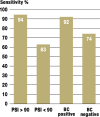Point-of-care testing in microbiology: the advantages and disadvantages of immunochromatographic test strips
- PMID: 19564967
- PMCID: PMC2695304
- DOI: 10.3238/arztebl.2009.0048
Point-of-care testing in microbiology: the advantages and disadvantages of immunochromatographic test strips
Abstract
Background: Point-of-care testing (POCT) for the demonstration of pathogens was introduced several years ago. The present study describes the current technical status of POCT, giving some examples, and summarizes the specific advantages and disadvantages of the POCT approach in microbiology.
Methods: Selective review of the literature found in medical databases under consideration of current German and international guidelines.
Results/conclusions: The test systems available today are technically mature and offer good to very good performance. For HIV, malaria, group A streptococci, and legionellae, POCT testing, when indicated, is on a par with conventional procedures. The information yielded by rapid tests for pneumococci and for influenza tends to be supplementary in nature. The rapid test for group B streptococci is unsuitable for routine use because its sensitivity is still too low compared with bacterial culture. POCT can be successful only if the tests are performed correctly by trained personnel, quality management procedures are followed, and the severity of illness and the epidemiological circumstances are taken into account when interpreting the results.
Keywords: diagnosis; immune diagnosis; infection risk; laboratory diagnosis; rapid testing.
Figures

Similar articles
-
Randomised controlled trial and health economic evaluation of the impact of diagnostic testing for influenza, respiratory syncytial virus and Streptococcus pneumoniae infection on the management of acute admissions in the elderly and high-risk 18- to 64-year-olds.Health Technol Assess. 2014 May;18(36):1-274, vii-viii. doi: 10.3310/hta18360. Health Technol Assess. 2014. PMID: 24875092 Free PMC article. Clinical Trial.
-
Improving the effectiveness of point of care tests for malaria and anaemia: a qualitative study across three Ghanaian antenatal clinics.BMC Health Serv Res. 2020 May 19;20(1):444. doi: 10.1186/s12913-020-05274-7. BMC Health Serv Res. 2020. PMID: 32429903 Free PMC article.
-
The evolution of rapid diagnostic testing in the management of influenza.MLO Med Lab Obs. 2012 Nov;44(11):40, 42. MLO Med Lab Obs. 2012. PMID: 23173525 No abstract available.
-
[Current status of POCT and its future challenges].Rinsho Byori. 2011 Sep;59(9):864-8. Rinsho Byori. 2011. PMID: 22111304 Review. Japanese.
-
Point-of-care testing in hospitals and primary care.Dtsch Arztebl Int. 2010 Aug;107(33):561-7. doi: 10.3238/arztebl.2010.0561. Epub 2010 Aug 20. Dtsch Arztebl Int. 2010. PMID: 20830271 Free PMC article. Review.
Cited by
-
Development of an immunochromatographic kit to detect severe acute respiratory syndrome coronavirus 2.J Virol Methods. 2021 Aug;294:114183. doi: 10.1016/j.jviromet.2021.114183. Epub 2021 May 11. J Virol Methods. 2021. PMID: 33984393 Free PMC article.
-
Molecular and Serological Tests for COVID-19 a Comparative Review of SARS-CoV-2 Coronavirus Laboratory and Point-of-Care Diagnostics.Diagnostics (Basel). 2020 Jun 26;10(6):434. doi: 10.3390/diagnostics10060434. Diagnostics (Basel). 2020. PMID: 32604919 Free PMC article. Review.
-
Unprotected sex in heterosexual partnerships of injecting drug users in st. Petersburg, Russia.AIDS Behav. 2011 Jan;15(1):58-64. doi: 10.1007/s10461-010-9721-0. AIDS Behav. 2011. PMID: 20532604 Free PMC article.
-
The use of rapid test QuikRead go® Strep A in bacterial pharyngotonsillitis diagnosing and therapeutic decisions.Eur J Clin Microbiol Infect Dis. 2017 Oct;36(10):1733-1738. doi: 10.1007/s10096-017-2986-8. Epub 2017 Apr 21. Eur J Clin Microbiol Infect Dis. 2017. PMID: 28429165
-
Microfluidic Systems for Antimicrobial Susceptibility Testing.Adv Biochem Eng Biotechnol. 2022;179:291-309. doi: 10.1007/10_2021_164. Adv Biochem Eng Biotechnol. 2022. PMID: 33851232
References
-
- Briedigkeit L, Müller-Plathe O, Schlebusch H, Ziems J. Patientennahe Laboratoriumsdiagnostik (Point-of-care-Testing) J Lab Med. 1998;22:414–420.
-
- Kassenärztliche Bundesvereinigung. Einheitlicher Bewertungsmaßstab (EBM), Stand 01. 01. 2008. Köln: Deutscher Ärzte-Verlag; 2007.
-
- Hess R, editor. Gebührenordnung für Ärzte (GOÄ) / UV-GOÄ. Köln: Deutscher Ärzte-Verlag; 2008.
-
- Junker R, Luppa P, Ziervogel H, Hoffmann G. Medizinische und wirtschaftliche Bedeutung von POCT. In: Luppa P, Schlebusch H, editors. Patientennahe Sofortdiagnostik (POCT) Heidelberg: Springer-Verlag; 2008. (in print)
-
- Kumar A, Roberts D, Wood KE, et al. Duration of hypotension before initiation of effective antimicrobial therapy is the critical determinant of survival in human septic shock. Crit Care Med. 2006;34:1589–1596. - PubMed
Publication types
MeSH terms
Substances
LinkOut - more resources
Full Text Sources

